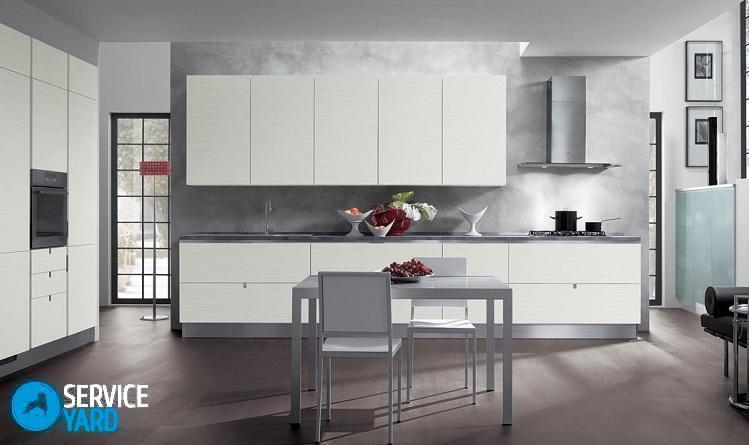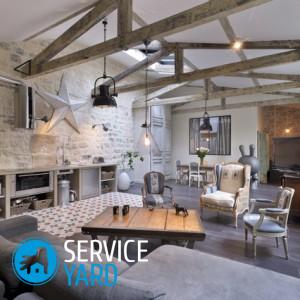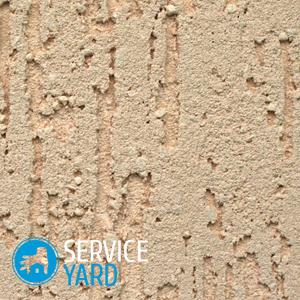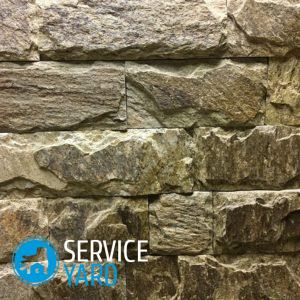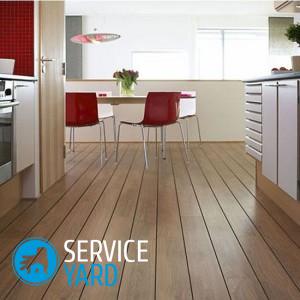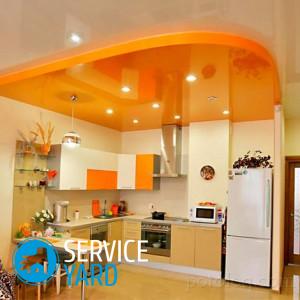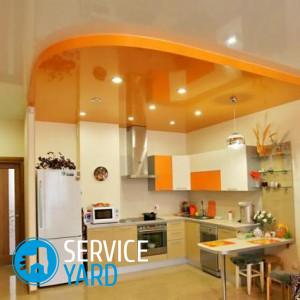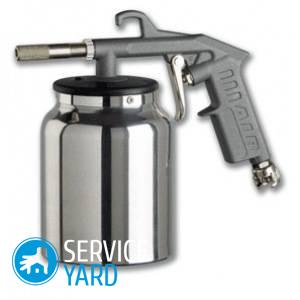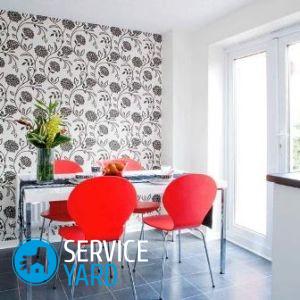Decorative plaster in the kitchen
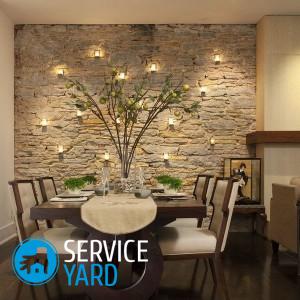
The kitchen in any apartment is a room that must withstand a lot of tests every day. This is high humidity, temperature changes, various pollution. Therefore, when planning repairs in this room, many owners begin to think about which wall covering to choose. Is it possible to avoid all the difficulties in caring for the interior and simplify the operation. Wallpaper, paint, tile - all this is too standard. But decorative plaster in the kitchen is an option that combines both beauty and ease of use. What it happens and how it is used - we will tell in this article.
to contents ↑Pros and cons
To maintain a balance between durability and beauty when choosing finishes for kitchen walls is not an easy task. Many apartment owners have a question, walls in the kitchen - what is the best finish: paint or decorative plaster?
The latter option is just able to embody many design ideas without sacrificing practicality. This material looks equally good in the spacious kitchens of multi-level apartments, and in tiny Khrushchev. It has several advantages:
- Durability. Decorative plaster in the kitchen with proper use will look like new, even after 20 years. Small defects - cracks or chips, can be repaired without much effort at any time.
- Working with this material, you won’t have a question how to mask joints and seams, as when working with wallpapers. This type of coating gives a smooth and uniform surface.
- If the rough surface in the room is far from ideal, then wall decoration in the kitchen with decorative plaster will be a real salvation, as it will hide all the flaws and defects.
- There are no toxic components in the plaster, so it is considered an environmentally friendly material, which is ideal for living quarters.
- Today, manufacturers are ready to offer you a lot of different options for both the color scheme and texture.
- The price category of this material can be designated as budget. There are, of course, species whose purchase will cost a pretty penny, but in most cases the cost is quite acceptable.
Important! Think about what kind of wall design you want to see in the end. And to make it easier for you to decide, we suggest considering these options:
Inspired by how the stucco of the walls looks in the kitchen, many forget that this material has its drawbacks:
- The most important is the complexity of the work associated with surface treatment. If even a beginner can cope with wallpapering, then plastering requires the correct setting of hands and a certain experience. It is also advisable to arm with special tools, for example, cartouche gun or hopper bucket.
- Some types of compounds, such as Venetian plaster in the kitchen, require prior alignment of the walls.
- This material is not suitable for newly constructed buildings. Plaster after hardening - the material is completely non-plastic. And at the slightest deformation that shrinkage can give, cracks appear on it.
to contents ↑Important! This material is difficult to apply, no less difficult to dismantle, only with a grinder or hammer.If you like to make repairs often, then choose a different finish for the walls. For example, there are various wallpaper options for the kitchen.
Stucco Features
At the word "plaster" in front of the eyes of many there is a gray mass that is used in the repair. This is a material for the intermediate stage of repair work, a kind of masking of various defects. Textured plaster for the kitchen is different. It is a topcoat and today this material itself dictates design trends. This happened largely due to the fact that additional components were added to the composition:
- The base of the plaster is divided by type of base. It can be acrylic, mineral, silicate and silicone.
- The filler is responsible for the texture and final appearance. Various materials are used here - quartz, crushed marble and granite, silk and even cotton.
- Additives that improve the composition - preservatives, antistatic agents, viscosity regulators.
- And the last component that acts as a solvent is water.
Determine the composition
If you are wondering, which plaster for the kitchen is which one to choose, then pay special attention to the basic component:
- Acrylic is a very plastic compound in which various pigments are added. It is sold ready-made. The main disadvantages are low vapor permeability, with constant exposure to sunlight, the surface begins to crack, so it is not suitable for external work.
- In the mineral base, the main component is cement. It is sold in powder form and is suitable for almost any job. Over time, such a coating only gains strength, is not afraid of ultraviolet radiation, but it is better not to expose the surface to mechanical stress.
Important! Also disadvantages include the fact that mineral plaster has a standard color palette.
- In the silicone material, the binder component is synthetic resins. It also tolerates various influences, as well as the mineral composition, has water-repellent properties, so it is perfect for both the kitchen and the bathroom. Sold in the form of a finished mixture of different colors.
- In silicate plaster, the binder is liquid glass. Therefore, it is considered the most durable, resistant to mold and rot. It is considered universal because it gives an excellent indicator of fire resistance and vapor permeability. This is one of the most durable compounds, the life of the surface treated by it can reach 50 years.
Important! In terms of practicality, the best choice of textured plaster for the kitchen is a synthetic coating based on silicone. It is durable and undemanding in care.
We select design
Probably the most difficult question will be which design to focus on:
- Textured plaster for the kitchen has a structured, slightly monotonous pattern, which is applied with special tools. It can be rollers, figured spatulas, sponges. The easiest way to create such a surface is to roll a freshly puttied wall with a roller, and then paint it to extend its life.
- Silk wall plaster in the kitchen is not the best option. Yes, such a surface, naturalistically imitating marble, looks gorgeous. But it has a very porous structure, with which it is difficult to remove contaminants. In addition, the wall will receive water-repellent properties only after processing with special waxes.
- Many consider Venetian stucco in the kitchen to be ideal. If the composition is applied competently, then you get a surface that exactly copies marble and looks very elegant. It is impossible to buy a Venetian in the kitchen, it can only be created. To do this, you will have to impose at least three layers of the composition, and each will have to work long and carefully.
to contents ↑Important! For those who decide to tackle this issue on their own, experienced craftsmen recommend betting on smooth glossy coatings. The smaller the roughness of the walls, the lower the likelihood that they will accumulate dust and dirt.
Preparation for work
When you have decided what decorative plaster in the kitchen will decorate the walls, it's time to prepare the necessary tools:
- The construction level, tape measure, building cord and plumb line are needed for measuring work.
- A mixer or a drill with a nozzle, a bucket, a spatula, usually a trowel will be needed in order to stir and apply the solution.
Preparation is also needed for the room in which work will be carried out:
- Free the kitchen from furniture. If this is not possible, then cover all the elements with cellophane. It is also worth doing with flooring.
- If you have old plaster, then ideally it is worth removing it. If this is not possible, then you need to carefully tap the entire wall and repair the fallen off areas to get a flat, smooth surface.
- After primed walls. This will give good adhesion and provide durability to the decorative coating.
to contents ↑Important! All surfaces in one room should be combined with each other. Therefore, first consider the options for finishing floors and ceilings, using the information from our reviews:
Stucco wall
Now you can safely proceed to the plastering of walls in the kitchen. Today, there are several ways to give a surface a special structure.
Spray method
This is the easiest method for applying textured plaster for the kitchen. It is also called “snowball”. It consists in the following: after the first layer has dried, the second is applied to the wall with the help of various tools and even improvised means.
Consider the method using a conventional broom:
- Take a broom in one hand and the most ordinary stick in the other.
- Wet the broom in a diluted composition and then sharply hit them on a stick. Splashes of the mixture fall on the wall and form an interesting pattern. Its texture depends on how dense the broom took, how often you spray the composition.
Important! An interesting effect is also achieved by the method in which the first layer of the composition on the wall is of one color, for example, blue, and the stucco with which you give the relief is of another, for example, white.
The Italian finish is done in a similar way:
- The first layer is applied and leveled, moreover, this must be done rather quickly.
- The second layer is applied, trying to block the previous one.
Important! The peculiarity of the method is that the layers are of different colors: one can be green, the second yellow.
- Until the material has hardened, it is smoothed.
The result is a surface in which both intertwine, sometimes dominating one another.
Relief with a trowel
You can create an original surface using conventional building tools, such as a trowel:
- Apply the first coat and wait for it to dry.
- On the instrument, draw a small amount of the mixture and apply a second layer. The movements should be light longitudinal, forming a pattern on the wall.
- Start work from above, from any angle.
- Do the docking of sections immediately, before they have frozen.
Important! The trowel for plastering walls in the kitchen should be well polished, then the mixture will not stick and interfere with the creation of the picture. A rectangular tool with rounded edges is recommended.
Textured method
With this option, you can even create murals on your walls. But you will need to apply several layers and paint them. The work is carried out at a fast pace, better by two masters, since the composition dries quickly:
- A thick layer of mortar is applied to the wall with a thick spatula. It is smoothed in different directions, reducing the thickness.At the same time, a relief is formed, and this operation must be completed in 15 minutes.
- The skills of the master in combination with the texture of the material form the final relief image, the coloring of which can be started two weeks after the plaster has completely dried. During this time, reliable adhesion of the layer to the base occurs.
Important! To avoid excessive roughness of the embossed surface, you can use a stucco mixture with fine-grained or granules mixed by granularity.
Hatching - Bouffant
In this way you need to process the newly applied plaster. And for work you will need a steel brush, the optimal wire length is 10 cm:
- You process a crude surface with smooth movements with a brush. They can be wavy or perpendicular to the direction.
- After that, wait for the surface to dry and remove particles of the composition that are weak to hold. This can be done with a sponge or soft brush.
Roller stamping
Another simple and easy way to decorate the walls of the kitchen with decorative plaster - using a roller:
- The tool can be patterned from formoplast or soft rubber.
- You can also use nap rollers to paint the walls.
- You smoothly process the surface of the wall and wait for the decorative layer to dry completely.
Important! If you use a patterned roller, then it makes sense to use it with plaster, which differs in color from the base.
Venetian
Venetian plaster in the kitchen is one of the most common options for decorating a room. But you are unlikely to cope with this work if you do not have experience, because a high-quality and beautiful Venetian in the kitchen is not obtained due to the special way of applying the composition. You need to know how many layers and what color you need to do in order to achieve a certain effect. And only experienced masters possess this knowledge.
to contents ↑Useful Tips
The use of decorative plaster in the kitchen can be widespread. But still there are nuances that should be considered before starting work:
- It is better to finish the wall around the perimeter of the working area at the sink and stove with more resistant material, for example, tiles or tempered glass.
- You can make the most of the material in the dining area. An interesting solution will be the allocation of the dining area from the working. To do this, just use a different application method or color.
- If desired, with the help of decorative plaster in the kitchen you can get a creative ceiling. Technologically, this is a complex process, but the result will be amazing, especially if you use different stencils or create an imitation of clouds using color.
- Textured plaster for the kitchen allows you to play various protrusions and indentations in the room. For example, a ventilation duct, using plaster, can be decorated in the form of an antique column. Then the disadvantage will turn into an advantage - the arch, the edges of which are decorated with a decorative composition, will become a spectacular detail of any interior.
Stock footage
Most likely, before reading this article, you did not even know what decorative stucco in the kitchen can be, because we are all used to the fact that this is the most common leveling compound. But knowing its composition, properties, additives, you can get very interesting coatings that can easily replace marble, but will cost much less. The main thing is to study all the main points of work and follow the recommendations.



